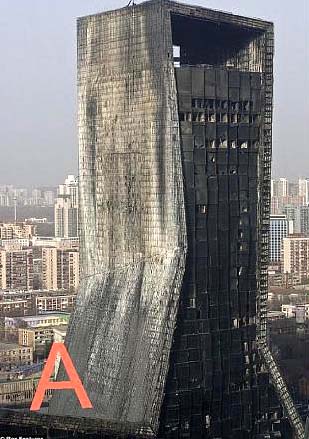From the February 2009 Idaho Observer:
Beijing sky scraper becomes towering inferno
|

The
photo above is the CCTV tower still standing after fire consumed all 44
floors, fueling speculation as to what caused the WTC 7 collapse.
|

The photos above show the CCTV tower ablaze
and a few fires in WTC 7 moments before it collapsed.
|
Building burns for hours, does not collapse
A recently constructed, 44-story Beijing skyscraper was set ablaze the evening of Feb. 9, 2009. After becoming engulfed in flames in an impressive nighttime conflagration witnessed by thousands celebrating the Chinese New Year, the building remained standing with its steel-beam framework completely intact.
The building was designed by Dutch architect Rem Koolhaas as part of the Chinese government’s pre-2008 Olympics building spree and part of China Central Television (CCTV)’s new headquarters. The fact that it did not collapse is consistent with the burning of every steel-framed building in world history with the exception of the Twin Towers and WTC 7 in New York on Sept. 11, 2001.
The official cause of the fire, which began at approximately 7:45 p.m., was "an unauthorized fireworks display." The fire began at ground level and quickly worked its way up, consuming all 44 floors and shooting flames 30 feet past the top floor before going out several hours later.
By contrast, only a few small, smoky fires of inexplicable origin were seen on eight floors of WTC 7 for a few hours and then the building imploded, collapsing in its own footprint at freefall speed.
The National Institutes of Standards and Technology (NIST) recently released its long-awaited "final report" on the WTC 7 collapse. The report invented a new concept called "thermal expansion" to explain the cause of the WTC 7 collapse. Prison Planet reporter Paul Joseph Watson concluded his coverage of the story by asking, "How do the [9/11 was an inside job] debunkers explain away this one? How come NIST’s newly invented ‘phenomenon’ of ‘thermal expansion’ didn’t apply to the skyscraper in Beijing? Does fire have different properties in China compared to the U.S.? Does it behave in different ways depending on what country it’s in?"

